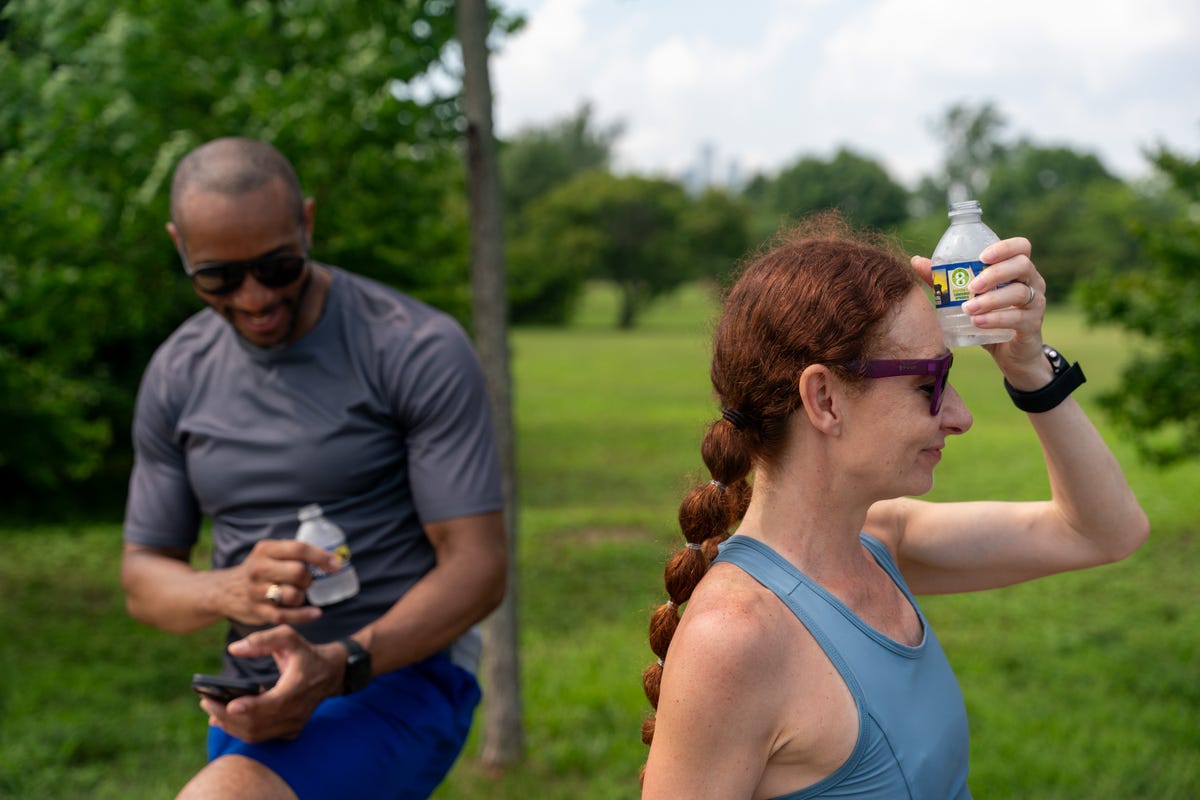Whether you’re doing an easy run or high-intensity intervals, you notice that your face never fails to turn beet-red. In fact, you feel that you always out-blush you running buddies and dread going red every time that you clock some miles. But why does this redness happen in the first place?
The good news is that facial redness during a run – or any other workout, for that matter – is totally normal and can happen to the best of us. That said, we can’t blame you for wondering why it happens and how to solve it, which is why we spoke with two dermatologists to find the answers.
Related StoryWhat causes your face to turn red during a run?
As we know – and as emphasised by Joshua Zeichner, associate professor of dermatology and the director of cosmetic and clinical research in dermatology at Mount Sinai Health System in the US – your core body temperature rises when you exercise. ‘As a response, blood vessels in your face dilate to bring more blood to your skin to release heat and keep your body cool,’ says Zeichner.
Although this happens to everyone, some people may still look redder than others. According to Shari Lipner, dermatologist at Weill Cornell Medicine and New York-Presbyterian, this additional redness may be due to things like genetics, skin colour (if you have lighter skin, for instance), an abundance of superficial blood vessels and skin conditions such as rosacea.
The length and intensity of your runs may also play a role in how red your face gets, adds Zeichner. ‘The more intense the exercise, the greater your body will respond to keep your core temperature cool,’ he says. ‘The longer the exercise, the longer your body will have to work.’
Both Zeichner and Lipner agree that it’s completely normal for your face to turn red during a run. ‘But if it’s getting in the way of daily activities or you find it bothersome, you should touch base with your dermatologist,’ says Zeichner – and we’ll explore that more below.
Related StoryHow long does your face stay red after a run?
In short, it varies. As Pilner says, your face can typically stay red for minutes up to over an hour after you’ve finished your workout, depending on things like the temperature that you’re running in, the intensity of your session and how hydrated you are.
‘It all depends on how long it takes your body to cool down and your genetically programmed ability for your blood vessels to reset,’ adds Zeichner. ‘People with more severe rosacea may experience long-lasting redness, discomfort or even facial swelling.’
Related StoryHow can you treat post-run facial redness?
According to both doctors, to help bring down your core body temperature and reduce facial redness after a run, it’s helpful to apply cool compresses and gentle moisturisers to your face, hydrate with cold water and, if you can, move into a cool or air conditioned room.
Related StoryHow can you prevent facial redness in the first place?
While you may not be able to put a complete stop to facial redness when you run, there are some simple steps that you can take to tone down that reddish glow. Lipner says that it helps to stay hydrated, limit runs in intense heat and wear sun protection, like sunscreen and a hat or cap, while Zeichner suggests wearing a neck fan or a cool towel around your neck if you can’t avoid running at peak temperatures.
That aside, Zeichner says that prescription topical medications like Rhofade help to constrict blood vessels and prevent exaggerated facial flushing. ‘It’s approved for persistent facial erythema of rosacea,’ he says. ‘The medicine works by blocking the receptors that tell the blood vessels to dilate.’
According to Rhofade’s website, you must tell your doctor if you have heart, blood vessel, blood pressure or circulation issues, as the medication may make these conditions worse and affect your ability to exercise safely.
Related StoryShould you worry about your face turning red during a run?
If your face gets red during a run, you’re not alone – and you don’t have to worry. It’s a normal sign that your body is cooling you down from your workout and you can always reduce the redness by using a cold compress on your face, drinking cold water or moving into a cooler area. However, if your facial redness bothers you, you can chat with a dermatologist about treatment options like topical creams.
Related Story
Danielle Zickl is a freelance writer who has 10 years of experience covering fitness, health, and nutrition. She’s a graduate of Ithaca College. You can find her work here on Women’s Health, and in many other publications including PS, SELF, Well+Good, Runner’s World, Outside RUN, Peloton, Men’s Fitness, and more.
Rachel is Runner’s World UK’s Senior Content Writer, covering all running-related topics from training advice and gear reviews to race reports and elite runner profiles. Formerly a Website Content Editor and Content Manager at London Marathon Events and The Running Channel respectively, Rachel is well-versed in the running scene and understands what it takes to put on some of the biggest running events in the world. A 2:50 marathoner, she would much rather run 26.2 miles than race a 5K and has currently completed 11 marathons, including five of the six Abbott World Marathon Majors in a sub-3 time. She now hopes to run the Tokyo Marathon to complete the set and become a Six Star Finisher.

